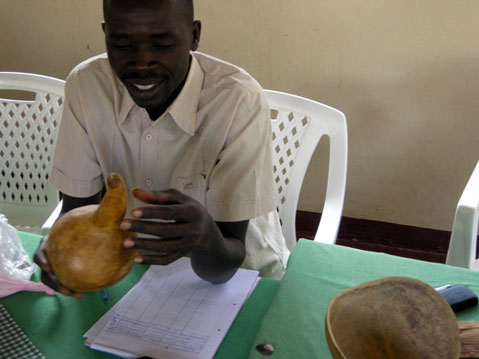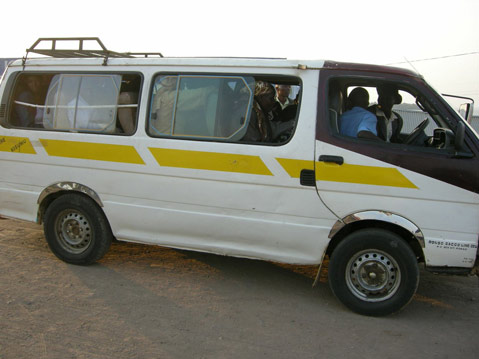Musings from a Matatu
Kenyan Buses, Old Schools, and Teacher Strikes

Matatu (ma-tah-too) n. –
1) A heart attack on wheels, frequently seen swerving wildly on Kenyan highways and country roads.
2) A Euro-style minivan that comes in a variety of makes and models, designed to seat 12 very small-statured people comfortably.
Typically decorated with curious names like The Blues, Manchester, God Saves, High Life, and Playboy Sensation.
This is it. This is the day I am going to die. If my mother could see me now, she would have a coronary. Yep, we are swerving into oncoming traffic to pass a lorry. We are 25 people deep. Circumstantially, these are my closest Kenyan friends, including Michelle, crammed in a wobbly matatu. Owner holding onto the roof. Rickety sliding door open. We are careening riotously through a rural two-lane highway in Western Kenya.
What happened to the bucolic landscape of the fertile Rift Valley we luxuriated above all afternoon from our air-conditioned EasyCoach perch? Oh yeah, the bus attendant failed to announce that we were supposed to change buses 20 kilometers back.
A call from Benson. Slight alarm in his voice.
“Brent, your bus has arrived, and you are not on it. There was only an older mzungu woman on it. She looked nothing like you.”
“Don’t worry,” I said, “the guy next to me said we are almost to Sirare, then we will be meeting up with you.”
“Get off the bus now,” said Benson. “You are on the wrong bus. You are almost to Tanzania.”
Whoops. I could only laugh (and mildly panic) as I squeezed my ogre-sized body into a ma-tah-too. Six live chickens, bound by their claws, randomly flutter and squawk in the cramped space at my feet. The “boot” bursting with mzungu gear held closed by a single length of frayed twine.

Waking in the West
After a harrowing matatu experience and a quick de-dusting before bed, I woke to the familiar pastoral sounds of roosters crowing, and children singing while herding cows, goats, and donkeys to the shores of Lake Victoria. The absence of the city. Perfect.
After a nice breakfast of strong Kenyan tea, white bread, jam, and peanut butter, my friend Fred stopped by to pick us up. Michelle and I were to participate in the community AIDS awareness event aimed at lowering the 32 percent infection rate that plagues this region of Kenya. The day was filled with yie (traditional Kenyan canoe) races on Lake Victoria, live Afro-reggae beats dropped by local musicians, sport competitions, and the tallest inflatable condom I have ever seen. Countless embraces and long-lasting handshakes with familiar faces welcomed me back to my African home.

New Observations of the Old School
We started the week with Benson touring a school I spent a lot of time at in 2011. Despite its founding in 1998, this school is yet to receive government funding for support staff or monies to feed and support students with physical disabilities living on its campus.
Even with the illegal nature of the funding situation, surprising progress has been made. A government infrastructure grant paid for a new Standard 8 (eighth grade in the U.S.) classroom, and the National Fund for the Disabled of Kenya provided a fence and is constructing a new wheelchair accessible dormitory. The new residence is to replace the current cramped 20’ x 30’ rooms that house 15 girls with physical disabilities in eight beds, and 20 boys with similar disabilities in 10 beds.
In spite of the label “special school,” the head teacher Erick feels his school is really an “inclusive school.” He explained that of the 63 students, there are 25 “boarders” with physical disabilities who live on the campus because their parents cannot afford to bring them to and from school daily. The other students without disabilities are siblings of the “boarders” and students who live in the neighborhood who attend the “special school” by choice.
I asked, “You mean all students in the neighborhood have the choice to attend the special school or the primary school?”
He replied, “Yes, many students choose to come to the special school because they want to be near their friends with disabilities.”
Trainings in Time of Strike
It was 9 a.m. on Wednesday morning, the first day of our teacher trainings. Due to a countrywide teacher strike, schools had been shut down for three weeks. I felt doubtful as we arrived at the hotel space we had to rent since our intended school space was not available to us.
“Don’t worry,” Benson assured us. “Teachers will come.”
Michelle and I began our training regimen we had anguished over for the past seven months. We had seven local teachers present interested in what we had to say, even though their teaching contract had not been honored since 1997. Needless to say, the 17-year breech of contract was perfectly timed to align with our project that relied on teachers willing to participate in trainings.
As we began outlining the Convention on the Rights of Persons with Disabilities (CRPD) and how Article 24 called for the development of an inclusive education system for countries that ratify it, more and more teachers filtered into the training space. By the end of the tea break, we had 15 teachers from seven primary schools and one special school along with two members of the Ministry of Education actively engaged in interactive no-cost community-building strategies.
We held the first of three inclusion committee meetings at the end of the first day of trainings. The committee was comprised of community members with and without disabilities, parents of children with and without disabilities, teachers from special schools and primary schools in the area, members of the Ministry of Education, and a partridge in a pear tree.
The committee prioritized the most pressing issues regarding access to inclusive education:
1) Increased community awareness of disabilities
2) Accessible schools (e.g., wider door frames, paved paths, and accessible latrines for wheelchair users)
3)Access to mobility devices for children with physical disabilities
The inaugural week included the introduction of a plethora of inclusive education strategies, complete with teachers thinking, pairing, and sharing, co-planning and performing inclusive lesson plans, and reflecting in groups on their burgeoning inclusive practices. We conversed and laughed over our daily tea breaks as static-filled TV news reports brought word that Kenyan teachers had been “sacked” by the government and schools had been permanently closed due to educator disobedience. Our captive audience was now officially unemployed, sans salary, and still committed to learning about inclusion.
As our first week with teachers came to an end, it concluded with a community member pledging to unite church and school communities on disability rights issues, a special education teacher presenting disability awareness information to a local chief’s council meeting, a principal willing to mobilize his students to remove physical barriers (e.g., rocks and tree stumps) on their campus for wheelchair users, and multiple committee members promising to contact friends and family members throughout Kenya to request donations for make this small region of Kenya more accessible for people with disabilities.
Not bad for a bunch of “disobedient” and now unemployed teachers.


